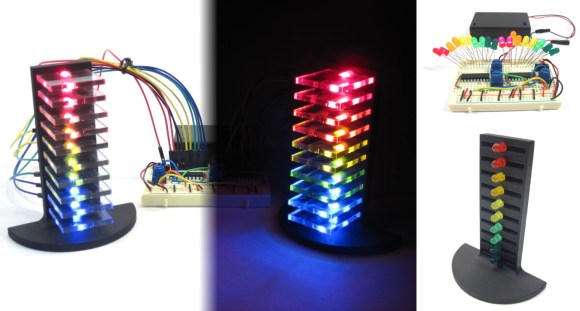
There are many very cool visual effects for music, but the best are the kind you build yourself. [Ben’s] mini LED volume towers adds some nice bling to your music.
[Ben] was inspired to created this project when he saw a variety of awesome stereo LED towers on YouTube (also referred to as VU meters). We have even featured a few VU meters, one very recently. [Ben] goes over every detail, including how to test your circuit (a very important part of any project). The schematic is deceptively simple. It is based on the LM3914 display driver IC, a simple chained comparator circuit is used to control the volume bar display. All you really need is a 3D printer to make the base, and you can build this awesome tower.
See the completed towers in action after the break. What next? It would be cool to see a larger tower that displays frequency magnitude!















Okay, the self made tower is pretty cool, but I already saw a version using WS2811 LEDs.
http://blog.simtronyx.de/stimmungsbeleuchtung-auf-basis-eines-ws2811-rgb-led-strips-einem-arduino-acrylglas-und-ein-paar-bauteilen-aus-dem-baumarkt/
This looks like it could also be done with an old Ikea CD tower or something similar.
Interesting way to make a fairly run of the mill LED VU meter into something more interesting and enjoyable.
These chips can be chained together for higher resolution displays. No ‘duino needed!
Where does it say he’s using an arduino?
This has to be one of the most appealing VU displays I have seen. Very nice build.
Interesting, I like the mechanicals of it, but even in TFA the author realised that since they didn’t use the logarithmic version of the meter IC, its just a voltmeter with an audio signal coming into it, not a VU meter. VU meter is a well defined thing, this is not it.
My only other suggestion would be to put some sort of coating on the tops and bottoms of the acrylic to keep the light from spreading too much to adjacent segments.
I’ll second this, and I’m glad the author recognized his oversight. The actual VU spec is quite exacting, and a great number of present day audio meters (even in professional gear) don’t actually follow it. Calling audio meters VU meters is essentially the same as calling tissues by the name Kleenex. Potatoes, potahtoes, I get it… but it’s a spec and it should get some respect, dagnabbit.
To wit, the VU design was such that the indicator would rise to 99% of 0 VU when a 1kHz sine wave is applied for 300ms, would have restricted overshoot, and would fall at the same rate. Anything else doesn’t get to use the name. Of course, when the standard was recorded by ANSI, BS, and IEC, it was prettied up a little bit and became: “The reading of the volume indicator shall be 0 VU when it is connected to an AC voltage equal to 1.228 Volts RMS across a 600 ohm resistance (equal to +4 [dBu]) at 1000 cycles per second.”
For more information, talk to your local broadcast engineer, refer to one of a number of broadcast engineering handbooks, or just check out wikipedia (https://en.wikipedia.org/wiki/VU_meter).
That said, there are a number of different metering styles/options available today in the audio/video/broadcast community, and each has its own merits. The most important element of using such a standard is that you stick to it from start to finish, understand what it takes to make it compliant with the requested target spec, and clearly document which standard you used.
For those wishing to see several different audio measurement methods at work all at once, I recommend the excellent (and free!) audio loudness meter from the good folks at Orban: http://www.orban.com/meter/ . For most casual musicians/recording folks, it’s probably the only metering you need, and there are a great number of professionals that rely it it quite heavily as well.
Someone’s a fan of Don Judd..! http://goo.gl/WOiNBL